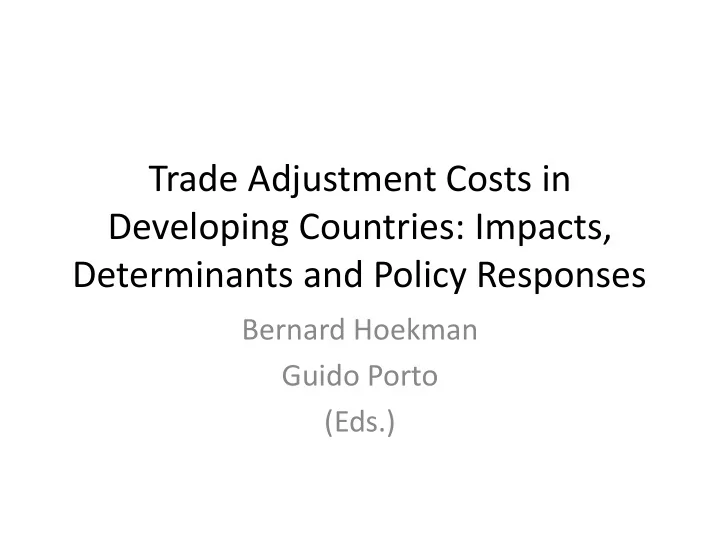

Trade Adjustment Costs in Developing Countries: Impacts, Determinants and Policy Responses Bernard Hoekman Guido Porto (Eds.)
Objective • Why is this important? p p a a b c p w Q
Objective • Why is this important? Without adjustment there are no gains from trade p p a a b c p w Adjustment of Adjustment of consumption production Q
Objective • Key concerns – How do agents adjust to take full advantage of the new trading opportunities? – How do agents ease the burden of adjusting to reforms? – How big are adjustment costs? – What factors drive the adjustment? – What can governments do? – Distributional conflicts when easing adjustment costs?
Objective • The Goals of this Project are: – Summarize the state of knowledge in the economic literature on trade and development regarding the costs of adjustment to trade openness – Describe how adjustment takes place in developing countries – Pull together in one place what is known and to use this as the basis for identifying areas for additional research • The book comprises 23 contributions by experts who focus on different dimensions of adjustment processes in developing countries • The authors were asked to summarize their own research and the state of play in their area of expertise
Overview of Contributions • The book is divided into four parts – Magnitude of trade adjustment costs – Adjustment impacts of trade shocks and greater trade openness – Factors that affect the way the economy adjusts – Trade adjustment assistance programs in the U.S. and compensation schemes for farmers in the EU
Magnitude of Adjustment Costs • Davidson and Matusz: general equilibrium model of labor market frictions • Artuc and McLaren: quantification of industry switching costs in Turkey • Casacuberta and Galdeman: factor adjustment functions in Uruguay • De Melo: adjustment costs in cashews in Mozambique and in vanilla in Madagascar • Cadot, Dutoit, Olarreaga: estimates of transaction-related costs (variable, fixed, and sunk) in Madagascar
Example • Subsistence farming in Madagascar – Estimate the costs of move out of subsistence farming in Madagascar by comparing revenue for market and subsistence farmers – Selection is important an identified with price volatility in the past and positive price shocks in the past. – Value subsistence farming using a price equation based on farm, regional and individual characteristics… – The sunk cost to shift out of subsistence is estimated at 120 to 150% of the annual output
Example – Who faces higher sunk cost to exit subsistence? • Large and young HH • No access to credit • High transport costs • With access to a national road • With access to association • Educated
Adjustment Impacts • Hanson: overall adjustment of the manufacturing sector • Muendler: the nature of labour reallocation in Brazil • MacMillan: the consequences of offshoring on labor markets • Hanson: the consequences of migration on labour markets • Krishna: the role of labour income risk • Edmonds: adjustment in child labour and schooling • Javorcik: the consequences of increased FDI • Harrigan: general patterns of adjustment to changes in trade policies • Bown: adjustments to trade policies of trade partners
Example Harrigan: describes the adjustment of exporters from developing • countries to the elimination of the ``Multi Fiber Arrangement’’ (MFA) Four major findings: • – China, which had been severely constrained by the MFA, registered a steep decline in export prices and soaring export volumes after the MFA ended, reflecting the country’s comparative advantage in low-wage products; – Other low-wage MFA-constrained exporters also saw big increases in their exports to the U.S.; – The ``East Asian Miracle’’ exporters experienced steep declines in export values, despite having large shares of filled quotas in 2004---the consequence of higher real wages and the end of preferential access to the U.S.; – Mexico suffered losses from the end of the MFA, as it lost its previously- privileged access to the U.S. market, but these losses were somewhat cushioned by its proximity to the U.S., a factor that insulated Mexico from competition from lower wage Asian exporters
Factors that Affect Adjustment • Hummels: transportation costs • Besedes and Prusa: duration of exports and search costs of trade partners • Arkolakis and Timoshenko: market penetration costs • Tybout: broad export costs (transport, marketing, market signaling) • Krishna: the role of distortions • Manova: credit constraints • Swinnen and Maertens: product standards
Adjustment Assistance Programs • Richardson: discusses the Trade Adjustment Assistance (TAA) program of the US • Swinnen: describes the history of the EU Common Agricultural Policy (CAP)
Future Research • Interaction between adjustment costs and institutions: – E.g.,Necessity for credible reforms, otherwise subsistence is optimal • Interaction between domestic and trade reforms • More on low-income countries, where missing markets are prevalent • How to assist?
Recommend
More recommend